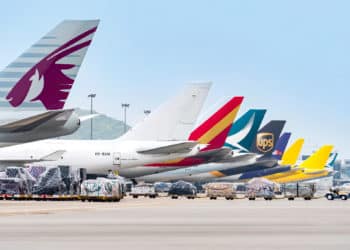No products in the cart.
IATA reports cargo traffic up 4.7% in May
The International Air Transport Association released its air freight market analysis for May 2014, showing an overall 4.7% year-over-year increase in worldwide cargo traffic. The growth came on the back of a 5.1% increase in international traffic, while domestic traffic was up just 2.6%. For the first five months of 2014, total traffic was up 4.4%, with international traffic up 4.6% and domestic traffic up 2.8%.
 The growth in May is up from the 3.2% y-o-y gain IATA reported in April, and IATA’s commentary on the data is quite different in tone from what it has said in recent months. Beginning with January, and continuing through April, IATA has said that although there has been reasonable growth in demand for air freight (up 4.2% for the year through April), there was underlying weakness in the world economy, particularly in China, and that the data showed “weakening in business activity measures and a pause in trade volume expansion, which is consistent with the flattening in the air freight growth trend.”
The growth in May is up from the 3.2% y-o-y gain IATA reported in April, and IATA’s commentary on the data is quite different in tone from what it has said in recent months. Beginning with January, and continuing through April, IATA has said that although there has been reasonable growth in demand for air freight (up 4.2% for the year through April), there was underlying weakness in the world economy, particularly in China, and that the data showed “weakening in business activity measures and a pause in trade volume expansion, which is consistent with the flattening in the air freight growth trend.”
Now, however, IATA says things may not be so bad after all. “There are indications that world trade and business confidence [are] improving after weakness in the first quarter. In particular, Chinese manufacturing activity rebounded in May, with a corresponding rise in export order growth.”
It is also worth pointing out that data gathered by Netherlands-based WorldACD have indicated stronger growth so far this year than what is being shown by IATA. As we reported earlier this week, WorldACD found air freight demand in May to be up 7.5% (compared to IATA’s 4.7%), and the gap was similar in April, with WorldACD data showing 6.8% growth while IATA’s data showed 3.2%.
The two organizations collect data in different ways, with IATA gathering reports of cargo traffic (in revenue tonne kilometers flown) from member airlines, while WorldACD gathers cargo volume data (in tonnes) directly from the airwaybills of over fifty carriers. Given the different methodologies, one would expect some differences in the result, but not as much as we’ve seen in the last two months.
Turning back to IATA’s report, we look at the May results by geographic region:
Middle East: Carriers from the Middle East continue to report strong growth in their cargo business, with traffic up 9.3% y-o-y in May. For the first five months of 2014, Middle East-based carriers reported their cargo traffic up 10.6%.
Asia-Pacific: Airlines based in the Asia-Pacific region have long carried the greatest share of global cargo traffic (about 40%), and they continue to do so. However, in the last few years, they have faced ever-increasing competition from carriers based in the Middle East, and this, combined with the weak demand environment led to declining traffic. Beginning in January, and continuing through the first five months of 2014, Asia’s carriers have reversed this trend, and are now reporting solid growth, with traffic up 5.3% in April, and 4.5% for the year to date. IATA has also reversed its somewhat negative tone regarding the region’s air freight prospects, saying that in addition to continuing benefits derived from economic growth in Europe and North America, traffic is being boosted by a return to growth of intra-Asia trade.
Europe: The continuing recovery of the European economy has benefited the region’s carriers, which reported cargo traffic up 3.4% in May, and up 4.1% for the year to date. IATA added that “Indicators of business activity suggest that the region will experience stronger economic growth in Q2 than at the start of the year.”
North America: Carriers in this region continue to report modest increases in cargo traffic, with May 2014 up 2.4% over April 2013. For the first four months of the year, North American carriers’ cargo traffic was up 1.8%. Looking ahead, IATA said: “Latest data show a rebound in trade volumes and underlying growth trends in business activity are positive, which could support stronger growth in trade and air freight demand ahead.”
Latin America: Trade in the Latin American region deteriorated in the early part of this year, and this curtailed air freight demand for the region’s carriers. However, the region’s carriers reported cargo traffic up 4.9%. a strong reversal from the 6.5% y-o-y drop in April. As IATA points out, the May results may be skewed by a spike in demand driven by the World Cup in Brazil, so it is too early to draw any conclusions about a turnaround. For the first five months of 2014, Latin American carriers reported their cargo traffic up 0.5%.
Africa: Air freight demand in Africa remains volatile, with cargo traffic growing in one month and declining the next. In May, cargo traffic for the region’s carriers was up 7.2%, which raised the year-to-date increase to 2.9%.




